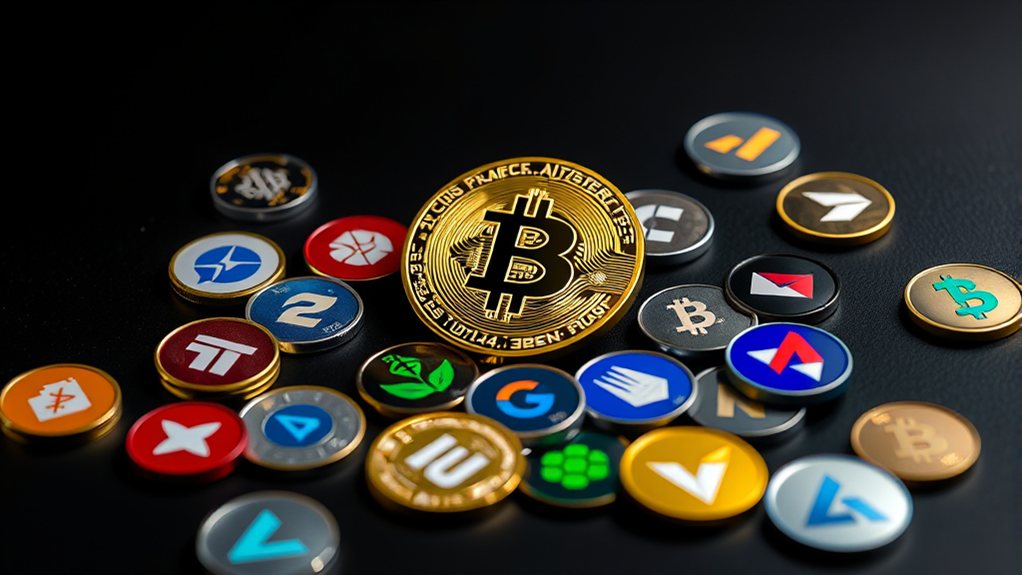Coins operate on their own blockchains, functioning as digital money for transactions and value storage. Tokens are built on existing blockchain platforms and represent assets or utilities within specific projects. Creating a coin requires developing an entire blockchain, while tokens can be made using smart contracts. Bitcoin and Ethereum are coins; ERC-20 tokens like Shiba Inu are tokens. Understanding this distinction helps investors navigate the cryptocurrency landscape more effectively.

As cryptocurrency markets continue to evolve, understanding the difference between coins and tokens has become essential for investors and users alike. These two terms are often used interchangeably, but they represent distinct digital assets with fundamental differences in how they function and what they're designed to do.
Coins are native to their own blockchain networks. Bitcoin, Ethereum, and Litecoin are prime examples of coins. Each operates on its independent infrastructure with unique rules and features. Coins were primarily created to serve as digital money. They function as a medium of exchange, a store of value, and a unit of account—similar to traditional currencies but in digital form.
Tokens, in contrast, don't have their own blockchain. They're built on existing blockchain platforms. The most common example is ERC-20 tokens that run on Ethereum's network. Shiba Inu, for instance, is a token on Ethereum, while Dogecoin is an independent coin with its own blockchain. Tokens typically represent assets or utilities within specific projects or ecosystems. Tokens enable the development of decentralized applications that provide innovative solutions across various industries. Unlike security tokens, utility tokens do not confer ownership rights but instead provide access to specific services or products within a blockchain ecosystem.
Unlike coins, tokens operate on existing blockchains, serving specific functions within particular ecosystems rather than as independent currencies.
The creation process differs greatly between coins and tokens. Developing a coin requires building an entire blockchain from scratch, including a consensus mechanism like proof-of-work or proof-of-stake. This is complex and resource-intensive.
Tokens are much simpler to create through smart contracts on established blockchains. This explains why there are thousands of tokens but relatively few coins. Tokens can be further categorized as utility, security, governance, or platform tokens based on their specific functions within the blockchain ecosystem.
Some cryptocurrencies have changed categories over time. Binance Coin (BNB) started as a token on Ethereum but later evolved to become a coin with its own blockchain. Tether (USDT) exists in both forms, operating as a token on multiple blockchains.
Coins generally enjoy broader acceptance and can be used across different platforms. Tokens are typically limited to their specific ecosystem. This distinction affects how widely they're accepted by exchanges and services.
Coins derive their value from network adoption and usage, while tokens' value is tied to the success of their associated projects.
From a regulatory standpoint, coins are often classified as commodities in many jurisdictions. Tokens, especially those representing ownership or profit rights, may fall under securities regulations. This regulatory difference can impact their legal status and how they're traded.
Understanding whether a cryptocurrency is a coin or token helps investors assess its purpose, potential use cases, and regulatory risks. Coins tend to function as general currencies with broader applications, while tokens serve specific purposes within particular ecosystems.
This fundamental distinction shapes how these digital assets operate in the evolving cryptocurrency landscape.
Frequently Asked Questions
Can Tokens Be Converted to Coins?
Yes, tokens can be converted to coins.
This process, called token migration or token swap, happens when projects move from one blockchain to another or launch their own blockchain.
Major cryptocurrencies like TRON, Binance Coin, and EOS have successfully completed such conversions.
The process typically involves a set conversion rate and requires token holders to participate by a specific deadline.
Exchanges often help with the conversion process.
Which Is More Secure: Coins or Tokens?
Security between coins and tokens isn't clearly one-sided.
Coins typically have dedicated security infrastructures on their native blockchains, while tokens rely on their host platform's security.
Larger coin networks often resist 51% attacks better, but tokens on established platforms like Ethereum benefit from ecosystem-wide security.
Both face unique vulnerabilities – coins to network attacks and tokens to smart contract exploits.
User practices ultimately impact security for both.
Are Stablecoins Considered Tokens or Coins?
Most stablecoins are technically tokens, not coins. They typically operate on existing blockchain platforms like Ethereum rather than having their own blockchain.
Popular stablecoins like USDT, USDC, and DAI function as ERC-20 tokens. Despite their name containing "coin," they're tokens because they depend on another blockchain's infrastructure for transactions and don't maintain their own independent network.
How Do Layer-2 Solutions Affect Coins and Tokens?
Layer-2 solutions greatly impact both coins and tokens by making transactions faster and cheaper. They increase transaction speed while reducing fees, making microtransactions practical.
These solutions enable more complex smart contracts and create new possibilities for DeFi applications. While layer-2 platforms inherit security from base blockchains, they introduce new trust considerations.
They also improve interoperability, allowing coins and tokens to move more easily between different blockchain networks.
Can Tokens Exist Without a Parent Blockchain?
No, tokens cannot exist independently without a parent blockchain. They rely entirely on existing blockchain infrastructures like Ethereum or Binance Smart Chain to operate.
Tokens use smart contracts on these host chains for all transactions and functionality.
While alternatives exist, such as wrapped tokens and cross-chain bridges, these still require some form of underlying blockchain to function.
Even layer-2 solutions remain anchored to base chains.










